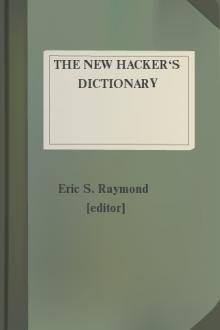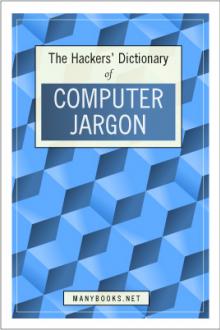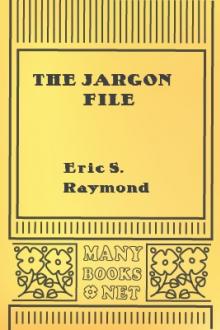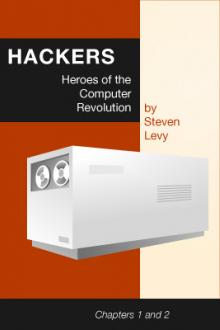The New Hacker's Dictionary by Eric S. Raymond (romantic novels to read .txt) 📕

- Author: Eric S. Raymond
- Performer: 0262680920
Book online «The New Hacker's Dictionary by Eric S. Raymond (romantic novels to read .txt) 📕». Author Eric S. Raymond
angle brackets n.
Either of the characters < (ASCII 0111100) and > (ASCII 0111110)
(ASCII less-than or greater-than signs). Typographers in the [532]Real
World use angle brackets which are either taller and slimmer (the ISO
Bra' andKet' characters), or significantly smaller (single or
double guillemets) than the less-than and greater-than signs. See
[533]broket, [534]ASCII.
Node:angry fruit salad, Next:[535]annoybot, Previous:[536]angle
brackets, Up:[537]= A =
angry fruit salad n.
A bad visual-interface design that uses too many colors. (This term
derives, of course, from the bizarre day-glo colors found in canned
fruit salad.) Too often one sees similar effects from interface
designers using color window systems such as [538]X; there is a
tendency to create displays that are flashy and attention-getting but
uncomfortable for long-term use.
Node:annoybot, Next:[539]annoyware, Previous:[540]angry fruit salad,
Up:[541]= A =
annoybot /*-noy-bot/ n.
[IRC] See [542]bot.
Node:annoyware, Next:[543]ANSI, Previous:[544]annoybot, Up:[545]= A =
annoyware n.
A type of [546]shareware that frequently disrupts normal program
operation to display requests for payment to the author in return for
the ability to disable the request messages. (Also called `nagware')
The requests generally require user action to acknowledge the message
before normal operation is resumed and are often tied to the most
frequently used features of the software. See also [547]careware,
[548]charityware, [549]crippleware, [550]freeware, [551]FRS,
[552]guiltware, [553]postcardware, and [554]-ware; compare
[555]payware.
Node:ANSI, Next:[556]ANSI standard, Previous:[557]annoyware, Up:[558]=
A =
ANSI /an'see/
n. [techspeak] The American National Standards Institute. ANSI,along with the International Organization for Standards (ISO),
standardized the C programming language (see [559]K&R, [560]Classic
C), and promulgates many other important software standards. 2. n.
[techspeak] A terminal may be said to be `ANSI' if it meets the ANSI
X.364 standard for terminal control. Unfortunately, this standard was
both over-complicated and too permissive. It has been retired and
replaced by the ECMA-48 standard, which shares both flaws. 3. n. [BBS
jargon] The set of screen-painting codes that most MS-DOS and Amiga
computers accept. This comes from the ANSI.SYS device driver that must
be loaded on an MS-DOS computer to view such codes. Unfortunately,
neither DOS ANSI nor the BBS ANSIs derived from it exactly match the
ANSI X.364 terminal standard. For example, the ESC-[1m code turns on
the bold highlight on large machines, but in IBM PC/MS-DOS ANSI, it
turns on intense' (bright) colors. Also, in BBS-land, the termANSI'
is often used to imply that a particular computer uses or can emulate
the IBM high-half character set from MS-DOS. Particular use depends on
context. Occasionally, the vanilla ASCII character set is used with
the color codes, but on BBSs, ANSI and `IBM characters' tend to go
together.
Node:ANSI standard, Next:[561]ANSI standard pizza, Previous:[562]ANSI,
Up:[563]= A =
ANSI standard /an'see stan'd*rd/
The ANSI standard usage of `ANSI standard' refers to any practice
which is typical or broadly done. It's most appropriately applied to
things that everyone does that are not quite regulation. For example:
ANSI standard shaking of a laser printer cartridge to get extra life
from it, or the ANSI standard word tripling in names of usenet alt
groups.
Node:ANSI standard pizza, Next:[564]AOL!, Previous:[565]ANSI standard,
Up:[566]= A =
ANSI standard pizza /an'see stan'drd peet'z/
[CMU] Pepperoni and mushroom pizza. Coined allegedly because most
pizzas ordered by CMU hackers during some period leading up to
mid-1990 were of that flavor. See also [567]rotary debugger; compare
[568]ISO standard cup of tea.
Node:AOL!, Next:[569]app, Previous:[570]ANSI standard pizza, Up:[571]=
A =
AOL! n.
[Usenet] Common synonym for "Me, too!" alluding to the legendary
propensity of America Online users to utter contentless "Me, too!"
postings. The number of exclamation points following varies from zero
to five or so. The pseudo-HTML
Me, too!
is also frequently seen. See also [572]September that never ended.
Node:app, Next:[573]arena, Previous:[574]AOL!, Up:[575]= A =
app /ap/ n.
Short for `application program', as opposed to a systems program. Apps
are what systems vendors are forever chasing developers to create for
their environments so they can sell more boxes. Hackers tend not to
think of the things they themselves run as apps; thus, in hacker
parlance the term excludes compilers, program editors, games, and
messaging systems, though a user would consider all those to be apps.
(Broadly, an app is often a self-contained environment for performing
some well-defined task such as `word processing'; hackers tend to
prefer more general-purpose tools.) See [576]killer app; oppose
[577]tool, [578]operating system.
Node:arena, Next:[579]arg, Previous:[580]app, Up:[581]= A =
arena n.
[common; Unix] The area of memory attached to a process by brk(2) and
sbrk(2) and used by malloc(3) as dynamic storage. So named from a
malloc: corrupt arena message emitted when some early versions
detected an impossible value in the free block list. See [582]overrun
screw, [583]aliasing bug, [584]memory leak, [585]memory smash,
[586]smash the stack.
Node:arg, Next:[587]ARMM, Previous:[588]arena, Up:[589]= A =
arg /arg/ n.
Abbreviation for `argument' (to a function), used so often as to have
become a new word (like piano' frompianoforte'). "The sine function
takes 1 arg, but the arc-tangent function can take either 1 or 2
args." Compare [590]param, [591]parm, [592]var.
Node:ARMM, Next:[593]armor-plated, Previous:[594]arg, Up:[595]= A =
ARMM n.
[acronym, `Automated Retroactive Minimal Moderation'] A Usenet
[596]cancelbot created by Dick Depew of Munroe Falls, Ohio. ARMM was
intended to automatically cancel posts from anonymous-posting sites.
Unfortunately, the robot's recognizer for anonymous postings triggered
on its own automatically-generated control messages! Transformed by
this stroke of programming ineptitude into a monster of
Frankensteinian proportions, it broke loose on the night of March 31,
1993 and proceeded to [597]spam news.admin.policy with a recursive
explosion of over 200 messages.
ARMM's bug produced a recursive [598]cascade of messages each of which
mechanically added text to the ID and Subject and some other headers
of its parent. This produced a flood of messages in which each header
took up several screens and each message ID and subject line got
longer and longer and longer.
Reactions varied from amusement to outrage. The pathological messages
crashed at least one mail system, and upset people paying line charges
for their Usenet feeds. One poster described the ARMM debacle as
"instant Usenet history" (also establishing the term [599]despew), and
it has since been widely cited as a cautionary example of the havoc
the combination of good intentions and incompetence can wreak on a
network. Compare [600]Great Worm; [601]sorcerer's apprentice mode. See
also [602]software laser, [603]network meltdown.
Node:armor-plated, Next:[604]asbestos, Previous:[605]ARMM, Up:[606]= A
=
armor-plated n.
Syn. for [607]bulletproof.
Node:asbestos, Next:[608]asbestos cork award,
Previous:[609]armor-plated, Up:[610]= A =
asbestos adj.
[common] Used as a modifier to anything intended to protect one from
[611]flames; also in other highly [612]flame-suggestive usages. See,
for example, [613]asbestos longjohns and [614]asbestos cork award.
Node:asbestos cork award, Next:[615]asbestos longjohns,
Previous:[616]asbestos, Up:[617]= A =
asbestos cork award n.
Once, long ago at MIT, there was a [618]flamer so consistently
obnoxious that another hacker designed, had made, and distributed
posters announcing that said flamer had been nominated for the
`asbestos cork award'. (Any reader in doubt as to the intended
application of the cork should consult the etymology under
[619]flame.) Since then, it is agreed that only a select few have
risen to the heights of bombast required to earn this dubious dignity
-- but there is no agreement on which few.
Node:asbestos longjohns, Next:[620]ASCII, Previous:[621]asbestos cork
award, Up:[622]= A =
asbestos longjohns n.
Notional garments donned by [623]Usenet posters just before emitting a
remark they expect will elicit [624]flamage. This is the most common
of the [625]asbestos coinages. Also asbestos underwear',asbestos
overcoat', etc.
Node:ASCII, Next:[626]ASCII art, Previous:[627]asbestos longjohns,
Up:[628]= A =
ASCII /as'kee/ n.
[originally an acronym (American Standard Code for Information
Interchange) but now merely conventional] The predominant character
set encoding of present-day computers. The standard version uses 7
bits for each character, whereas most earlier codes (including early
drafts of of ASCII prior to June 1961) used fewer. This change allowed
the inclusion of lowercase letters -- a major [629]win -- but it did
not provide for accented letters or any other letterforms not used in
English (such as the German sharp-S or the ae-ligature which is a
letter in, for example, Norwegian). It could be worse, though. It
could be much worse. See [630]EBCDIC to understand how. A history of
ASCII and its ancestors is at
[631]http://www.wps.com/texts/codes/index.html.
Computers are much pickier and less flexible about spelling than
humans; thus, hackers need to be very precise when talking about
characters, and have developed a considerable amount of verbal
shorthand for them. Every character has one or more names -- some
formal, some concise, some silly. Common jargon names for ASCII
characters are collected here. See also individual entries for
[632]bang, [633]excl, [634]open, [635]ques, [636]semi, [637]shriek,
[638]splat, [639]twiddle, and [640]Yu-Shiang Whole Fish.
This list derives from revision 2.3 of the Usenet ASCII pronunciation
guide. Single characters are listed in ASCII order; character pairs
are sorted in by first member. For each character, common names are
given in rough order of popularity, followed by names that are
reported but rarely seen; official ANSI/CCITT names are surrounded by
brokets: <>. Square brackets mark the particularly silly names
introduced by [641]INTERCAL. The abbreviations "l/r" and "o/c" stand
for left/right and "open/close" respectively. Ordinary parentheticals
provide some usage information.
!
Common: [642]bang; pling; excl; shriek; ball-bat; <exclamation mark>. Rare: factorial; exclam; smash; cuss; boing; yell; wow; hey; wham; eureka; [spark-spot]; soldier, control."
Common: double quote; quote. Rare: literal mark; double-glitch; <quotation marks>; <dieresis>; dirk; [rabbit-ears]; double prime. Common: number sign; pound; pound sign; hash; sharp; [643]crunch; hex; [mesh]. Rare: grid; crosshatch; octothorpe; flash; <square>, pig-pen; tictactoe; scratchmark; thud; thump; [644]splat.$
Common: dollar; <dollar sign>. Rare: currency symbol; buck; cash; string (from BASIC); escape (when used as the echo of ASCII ESC); ding; cache; [big money].%
Common: percent; <percent sign>; mod; grapes. Rare: [double-oh-seven].&
Common: <ampersand>; amper; and, and sign. Rare: address (from C); reference (from C++); andpersand; bitand; background (from sh(1)); pretzel; amp. [INTERCAL called this `ampersand'; what could be sillier?]'
Common: single quote; quote; <apostrophe>. Rare: prime; glitch; tick; irk; pop; [spark]; <closing single quotation mark>; <acute accent>.( )
Common: l/r paren; l/r parenthesis; left/right; open/close; paren/thesis; o/c paren; o/c parenthesis; l/r parenthesis; l/r banana. Rare: so/already; lparen/rparen; <opening/closing parenthesis>; o/c round bracket, l/r round bracket, [wax/wane]; parenthisey/unparenthisey; l/r ear.*
Common: star; [[645]splat]; <asterisk>. Rare: wildcard; gear; dingle; mult; spider; aster; times; twinkle; glob (see [646]glob); [647]Nathan Hale.+
Common: <plus>; add. Rare: cross; [intersection].,
Common: <comma>. Rare: <cedilla>; [tail].-
Common: dash; <hyphen>; <minus>. Rare: [worm]; option; dak; bithorpe..
Common: dot; point; <period>; <decimal point>. Rare: radix point; full stop; [spot]./
Common: slash; stroke; <slant>; forward slash. Rare: diagonal; solidus; over; slak; virgule; [slat].:
Common: <colon>. Rare: dots; [two-spot].;
Common: <semicolon>; semi. Rare: weenie; [hybrid], pit-thwong.< >
Common: <less/greater than>; bra/ket; l/r angle; l/r angle bracket; l/r broket. Rare: from/{into, towards}; read from/write to; suck/blow; comes-from/gozinta; in/out; crunch/zap (all from UNIX); tic/tac; [angle/right angle].=
Common: <equals>; gets; takes. Rare: quadrathorpe; [half-mesh].?
Common: query; <question mark>; [648]ques. Rare: whatmark; [what]; wildchar; huh; hook; buttonhook; hunchback.@
Common: at sign; at; strudel. Rare: each; vortex; whorl; [whirlpool]; cyclone; snail; ape; cat; rose; cabbage; <commercial at>.V
Rare: [book].[ ]
Common: l/r square bracket; l/r bracket; <opening/closing bracket>; bracket/unbracket. Rare: square/unsquare; [U turn/U turn back]. Common: backslash,




Comments (0)